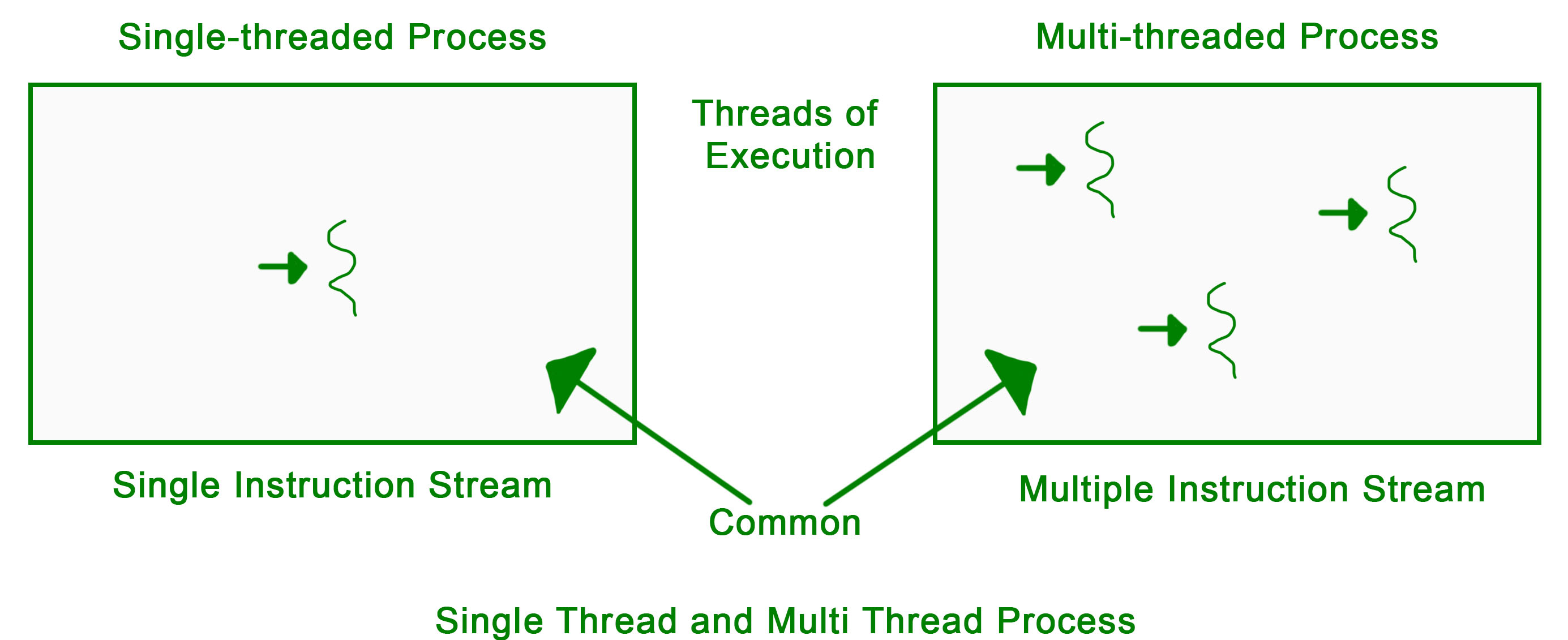Multithreading in Operating System
Last Updated :
19 Jul, 2023
A thread is a path which is followed during a program’s execution. Majority of programs written now a days run as a single thread.Lets say, for example a program is not capable of reading keystrokes while making drawings. These tasks cannot be executed by the program at the same time. This problem can be solved through multitasking so that two or more tasks can be executed simultaneously. Multitasking is of two types: Processor based and thread based. Processor based multitasking is totally managed by the OS, however multitasking through multithreading can be controlled by the programmer to some extent. The concept of multi-threading needs proper understanding of these two terms – a process and a thread. A process is a program being executed. A process can be further divided into independent units known as threads. A thread is like a small light-weight process within a process. Or we can say a collection of threads is what is known as a process.  Applications – Threading is used widely in almost every field. Most widely it is seen over the internet nowadays where we are using transaction processing of every type like recharges, online transfer, banking etc. Threading is a segment which divide the code into small parts that are of very light weight and has less burden on CPU memory so that it can be easily worked out and can achieve goal in desired field. The concept of threading is designed due to the problem of fast and regular changes in technology and less the work in different areas due to less application. Then as says “need is the generation of creation or innovation” hence by following this approach human mind develop the concept of thread to enhance the capability of programming.
Applications – Threading is used widely in almost every field. Most widely it is seen over the internet nowadays where we are using transaction processing of every type like recharges, online transfer, banking etc. Threading is a segment which divide the code into small parts that are of very light weight and has less burden on CPU memory so that it can be easily worked out and can achieve goal in desired field. The concept of threading is designed due to the problem of fast and regular changes in technology and less the work in different areas due to less application. Then as says “need is the generation of creation or innovation” hence by following this approach human mind develop the concept of thread to enhance the capability of programming.
Lifecycle of a thread
There are various stages in the lifecycle of a thread. Following are the stages a thread goes through in its whole life.
- New: The lifecycle of a born thread (new thread) starts in this state. It remains in this state till a program starts.
- Runnable: A thread becomes runnable after it starts. It is considered to be executing the task given to it.
- Waiting: While waiting for another thread to perform a task, the currently running thread goes into the waiting state and then transitions back again after receiving a signal from the other thread.
- Timed Waiting: A runnable thread enters into this state for a specific time interval and then transitions back when the time interval expires or the event the thread was waiting for occurs.
- Terminated (Dead): A thread enters into this state after completing its task.
Types of execution in OS
There are two types of execution:
- Concurrent Execution: This occurs when a processor is successful in switching resources between threads in a multithreaded process on a single processor.
- Parallel Execution: This occurs when every thread in the process runs on a separate processor at the same time and in the same multithreaded process
Drawbacks of Multithreading
Multithreading is complex and many times difficult to handle. It has a few drawbacks. These are:
- If you don’t make use of the locking mechanisms properly, while investigating data access issues there is a chance of problems arising like data inconsistency and dead-lock.
- If many threads try to access the same data, then there is a chance that the situation of thread starvation may arise. Resource contention issues are another problem that can trouble the user.
- Display issues may occur if threads lack coordination when displaying data.
Benefits of Multithreading:
- Multithreading can improve the performance and efficiency of a program by utilizing the available CPU resources more effectively. Executing multiple threads concurrently, it can take advantage of parallelism and reduce overall execution time.
- Multithreading can enhance responsiveness in applications that involve user interaction. By separating time-consuming tasks from the main thread, the user interface can remain responsive and not freeze or become unresponsive.
- Multithreading can enable better resource utilization. For example, in a server application, multiple threads can handle incoming client requests simultaneously, allowing the server to serve more clients concurrently.
- Multithreading can facilitate better code organization and modularity by dividing complex tasks into smaller, manageable units of execution. Each thread can handle a specific part of the task, making the code easier to understand and maintain.
Like Article
Suggest improvement
Share your thoughts in the comments
Please Login to comment...